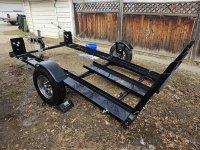I just purchased a used 2020 Stinger Can Am trailer and pulled it empty 11 hrs back home. It fish tailed the whole way. Has anyone else experienced this or similar pulling the trailer without the Spyder?
I can't imagine Stinger manufacturing a trailer that has weight distribution issues when empty. Is this common or maybe just an issue with the one I purchased.
I appreciate any feedback.
This is most likely related to the height of the hitch on your tow vehicle, as an empty trailer of this type has almost certainly has been designed to track true - unless maybe it's been damaged at some stage & the axle or something else has somehow been bent in an irregular way?? :dontknow:
So try this: Hitch up the trailer to your tow vehicle & park both on level ground somewhere you can look at them side-on from at least 20 feet off to one side. The front of the trailer body should be marginally lower than the rear of the trailer. I don't think it's worth measuring anything, your Mark 1 Eyeball should be good enough for this exercise (mainly cos I really don't want to go into the calculations over total length, drawbar length/height, & axle to drawbar length & height et al that determine the ideal hitch height/length/axle relationship, cos that sorta stuff hurts my brain these days

) but you need to have a slight downward tilt toward the front of the trailer body, and the hitch point on your tow vehicle needs to be low enough to cater for that. Generally, a few inches of forward tilt on the trailer body will be fine, but without that forward tilt, the trailer will likely fish-tail unless it's heavy enough/loaded heavily enough to counter the nose-up effect!

If your hitch height puts the trailer body absolutely level or worse, nose up, then you need to get a hitch extension to drop the tow-ball/pivot point down enough to change that into a nose down attitude. That
SHOULD iron out the fish-tailing; an alternative is to carry some weight forward of the axle that puts at least 10% of the total towed weight onto the hitch point... and that might mean fixing a box or some sort of platform to the drawbar in a way that'd mess up the foldability of the stinger trailer.
Ps: Many people do over-inflate their trailer tires needlessly, and that certainly won't help! :banghead: Regardless of the fact that they're trailer tires and need to be
CAPABLE of carrying a heavy load; trailer tires still only need sufficient air in them to carry the load that they are actually bearing
RIGHT NOW, or they can induce unwanted handling, wear, puncture risk, and stability issues simply cos they'll be causing the trailer to bounce around a
LOT!! :shocked:

